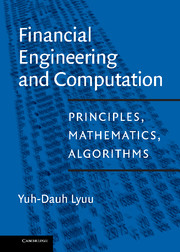Book contents
- Frontmatter
- Contents
- Preface
- Useful Abbreviations
- 1 Introduction
- 2 Analysis of Algorithms
- 3 Basic Financial Mathematics
- 4 Bond Price Volatility
- 5 Term Structure of Interest Rates
- 6 Fundamental Statistical Concepts
- 7 Option Basics
- 8 Arbitrage in Option Pricing
- 9 Option Pricing Models
- 10 Sensitivity Analysis of Options
- 11 Extensions of Options Theory
- 12 Forwards, Futures, Futures Options, Swaps
- 13 Stochastic Processes and Brownian Motion
- 14 Continuous-Time Financial Mathematics
- 15 Continuous-Time Derivatives Pricing
- 16 Hedging
- 17 Trees
- 18 Numerical Methods
- 19 Matrix Computation
- 20 Time Series Analysis
- 21 Interest Rate Derivative Securities
- 22 Term Structure Fitting
- 23 Introduction to Term Structure Modeling
- 24 Foundations of Term Structure Modeling
- 25 Equilibrium Term Structure Models
- 26 No-Arbitrage Term Structure Models
- 27 Fixed-Income Securities
- 28 Introduction to Mortgage-Backed Securities
- 29 Analysis of Mortgage-Backed Securities
- 30 Collateralized Mortgage Obligations
- 31 Modern Portfolio Theory
- 32 Software
- 33 Answers to Selected Exercises
- Bibliography
- Glossary of Useful Notations
- Index
12 - Forwards, Futures, Futures Options, Swaps
Published online by Cambridge University Press: 19 September 2009
- Frontmatter
- Contents
- Preface
- Useful Abbreviations
- 1 Introduction
- 2 Analysis of Algorithms
- 3 Basic Financial Mathematics
- 4 Bond Price Volatility
- 5 Term Structure of Interest Rates
- 6 Fundamental Statistical Concepts
- 7 Option Basics
- 8 Arbitrage in Option Pricing
- 9 Option Pricing Models
- 10 Sensitivity Analysis of Options
- 11 Extensions of Options Theory
- 12 Forwards, Futures, Futures Options, Swaps
- 13 Stochastic Processes and Brownian Motion
- 14 Continuous-Time Financial Mathematics
- 15 Continuous-Time Derivatives Pricing
- 16 Hedging
- 17 Trees
- 18 Numerical Methods
- 19 Matrix Computation
- 20 Time Series Analysis
- 21 Interest Rate Derivative Securities
- 22 Term Structure Fitting
- 23 Introduction to Term Structure Modeling
- 24 Foundations of Term Structure Modeling
- 25 Equilibrium Term Structure Models
- 26 No-Arbitrage Term Structure Models
- 27 Fixed-Income Securities
- 28 Introduction to Mortgage-Backed Securities
- 29 Analysis of Mortgage-Backed Securities
- 30 Collateralized Mortgage Obligations
- 31 Modern Portfolio Theory
- 32 Software
- 33 Answers to Selected Exercises
- Bibliography
- Glossary of Useful Notations
- Index
Summary
It does not matter if I speak; the future has already been determined.
Sophocles (496 B.C.–406 B.C.), Oedipus TyrannusThis chapter continues the coverage of derivatives, financial contracts whose value depends on the value of some underlying assets or indices. Derivatives are essential to risk management, speculation, efficient portfolio adjustment, and arbitrage. Interest-rate-sensitive derivative securities require a separate chapter, Chap. 21.
Introduction
Many financial institutions take large positions in derivatives. For example, Chase Manhattan held U.S.$7.6 trillion (notional amount) in derivatives as of early 1998 [57]. Trading derivatives can be risky, however. The loss of U.S.$1.6 billion in the case of Orange County, California, led to its bankruptcy in December 1994 and the securities firms involved paying U.S.$739 million in subsequent settlements [527]; the value of an interest rate swap held by Sears in 1997 was a minus U.S.$382 million based on a notional principal of U.S.$996 million [884]; J.P. Morgan in 1997 had U.S.$659 million in nonperforming assets, 90% of which were defaults from Asian counterparties; Union Bank of Switzerland (UBS) wrote off U.S.$699 million because of investment in the hedge fund, Long-Term Capital Management (LTCM).
Four types of derivatives stand out: futures contracts, forward contracts, options, and swaps. Futures contracts and forward contracts are contracts for future delivery of the underlying asset. The underlying asset can be a physical commodity (corn, oil, live cattle, pork bellies, precious metals, and so on) or financial instrument (bonds, currencies, stock indices, mortgage securities, other derivatives, and so on) [95, 470].
- Type
- Chapter
- Information
- Financial Engineering and ComputationPrinciples, Mathematics, Algorithms, pp. 155 - 176Publisher: Cambridge University PressPrint publication year: 2001



